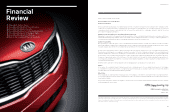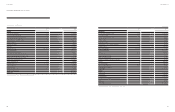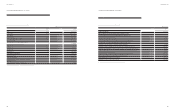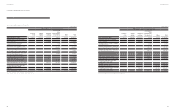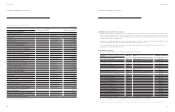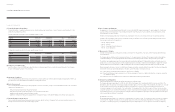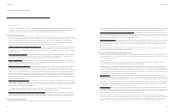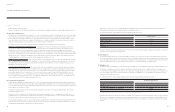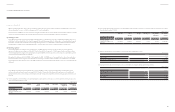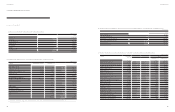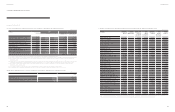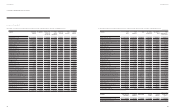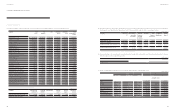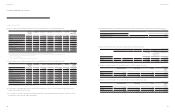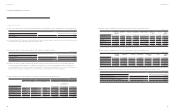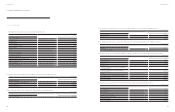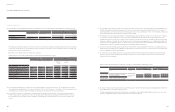Kia 2014 Annual Report Download - page 42
Download and view the complete annual report
Please find page 42 of the 2014 Kia annual report below. You can navigate through the pages in the report by either clicking on the pages listed below, or by using the keyword search tool below to find specific information within the annual report.
December 31, 2014 and 2013
Notes to the Consolidated
Financial Statements
KIA MOTORS CORPORATION AND SUBSIDIARIES
(r) Provisions
Provisions are recognized when the Company has a present legal or constructive obligation as a result of a past event, it is probable that an outow of
resources embodying economic benets will be required to settle the obligation and a reliable estimate can be made of the amount of the obligation.
The risks and uncertainties that inevitably surround many events and circumstances are taken into account in reaching the best estimate of a
provision. Where the effect of the time value of money is material, provisions are determined at the present value of the expected future cash ows.
Where some or all of the expenditures required to settle a provision are expected to be reimbursed by another party, the reimbursement shall be
recognized when, and only when, it is virtually certain that reimbursement will be received if the entity settles the obligation. The reimbursement
is treated as a separate asset.
Provisions are reviewed at the end of each reporting period and adjusted to reect the current best estimates. If it is no longer probable that an
outow of resources embodying economic benets will be required to settle the obligation, the provision is reversed.
A provision for warranties is recognized when the underlying products or services are sold. The provision is based on historical warranty data and
a weighting of all possible outcomes against their associated probabilities.
A provision shall be used only for expenditures for which the provision was originally recognized.
(s) Foreign currency
Transactions in foreign currencies are translated to the respective functional currencies of the Company entities at exchange rates at the dates of
the transactions. Monetary assets and liabilities denominated in foreign currencies are retranslated to the functional currency using the reporting
date’s exchange rate. Non-monetary assets and liabilities denominated in foreign currencies that are measured at fair value are retranslated to
the functional currency at the exchange rate at the date that the fair value was determined. Non-monetary items that are measured in terms of
historical cost in a foreign currency are translated using the exchange rate at the date of the transaction.
Foreign currency differences arising on retranslation are recognized in prot or loss, except for differences arising on a nancial liability
designated as a hedge of the net investment in a foreign operation, or qualifying cash ow hedges, which are recognized in other comprehensive
income. Also, foreign currency differences arising on settlement of Monetary assets and liabilities are recognized in prot or loss.
The assets and liabilities of foreign operations are translated to presentation currency at exchange rates at the reporting date. The income and
expenses of foreign operations are translated to presentation currency at exchange rates at the dates of the transactions. Foreign currency
differences are recognized in other comprehensive income.
(t) Equity capital
Ordinary shares are classied as equity. Incremental costs directly attributable to the issuance of ordinary shares and share options are recognized
as a deduction from equity, net of any tax effects.
When the Company repurchases its share capital, the amount of the consideration paid is recognized as a deduction from equity and classied as
treasury shares. The prots or losses from the purchase, disposal, reissue, or retirement of treasury shares are not recognized as current prot or
loss. If the Company acquires and retains treasury shares, the consideration paid or received is directly recognized in equity.
(u) Revenue
Revenue from sale of goods or the use by others of the Company assets is measured at the fair value of the consideration received or receivable,
net of returns, trade discounts, volume rebates and cash incentives to the customers.
Revenue from sales of vehicles, service parts and other related products is recognized when the Company has transferred to the buyer the
signicant risk and rewards of ownership of the goods, the Company retains neither continuing managerial involvement to the degree usually
associated with ownership nor effective control over the goods sold, the amount of revenue can be measured reliably, it is probable that the
economic benets associated with the transaction will ow to the Company and the costs incurred or to be incurred in respect of the transaction
can be measured reliably.
The Company accounts for sales of goods and services under Q Point Program as transactions with multiple revenue generation activities or
deliverables. The fair value of the consideration received or receivable in respect of the initial sale is allocated between the award credits (“Q
Points”) and the other components of the sale. The amount allocated to the Q Points is estimated by reference to the fair value of the points for
which they could be sold separately. Such amount is deferred and revenue is recognized only when the Q Points are redeemed and the Company
has fullled its obligations rather than the initial point of sales of goods and services.
Rental income from investment property is recognized in prot or loss on straight-line basis over the term of the lease.
(v) Finance income and nance costs
Finance income comprises interest income on funds invested (including available-for-sale nancial assets), dividend income except for dividend
from investment in associates, gains on the disposal of available-for-sale nancial assets, changes in the fair value of nancial assets at fair value
through prot or loss, and gains on hedging instruments that are recognized in prot or loss. Interest income is recognized as it accrues in
prot or loss, using the effective interest method. Dividend income is recognized in prot or loss on the date that the Company’s right to receive
payment is established, which in the case of quoted securities is the ex-dividend date.
Finance costs comprise interest expense on borrowings, unwinding of the discount on provisions and losses on hedging instruments that are
recognized in prot or loss. Interest expense of borrowings is recognized as it accrues in prot or loss, using the effective interest method.
(w) Income taxes
Income tax expense comprises current and deferred tax. Current tax and deferred tax are recognized in prot or loss except to the extent that it
relates to a business combination, or items recognized directly in equity or in other comprehensive income.
CURRENT TAX Current tax is the expected tax payable or receivable on the taxable prot or loss for the year, using tax rates enacted or
substantively enacted at the end of the reporting period and any adjustment to tax payable in respect of previous years.The taxable prot is
different from the accounting prot for the period since the taxable prot is calculated excluding the temporary differences, which will be taxable
or deductible in determining taxable prot (tax loss) of future periods, and non-taxable or non-deductible items from the accounting prot.
DEFERRED TAX Deferred tax is recognized, using the asset-liability method, in respect of temporary differences between the carrying amounts
of assets and liabilities for nancial reporting purposes and the amounts used for taxation purposes. A deferred tax liability is recognized for
all taxable temporary differences. A deferred tax asset is recognized for all deductible temporary differences to the extent that it is probable
that taxable prot will be available against which they can be utilized. However, deferred tax is not recognized for the following temporary
differences: taxable temporary differences arising on the initial recognition of goodwill, or the initial recognition of assets or liabilities in a
transaction that is not a business combination and that affects neither accounting prot or loss nor taxable income.
The Company recognizes a deferred tax liability for all taxable temporary differences associated with investments in subsidiaries, associates and
interests in joint ventures, except to the extent that the Company is able to control the timing of the reversal of the temporary difference and it is
probable that the temporary difference will not reverse in the foreseeable future. The Company recognizes a deferred tax asset for all deductible
temporary differences arising from investments in subsidiaries and associates, to the extent that it is probable that the temporary difference will
reverse in the foreseeable future and taxable prot will be available against which the temporary difference can be utilized.
The carrying amount of a deferred tax asset is reviewed at the end of each reporting period and reduces the carrying amount to the extent that it
is no longer probable that sufcient taxable prot will be available to allow the benet of part or all of that deferred tax asset to be utilized.
Deferred tax assets and liabilities are measured at the tax rates that are expected to apply to the period when the asset is realized or the liability is
settled, based on tax laws that have been enacted or substantively enacted by the end of the reporting period. The measurement of deferred tax
80 81
Annual Report 2014Financial Review


